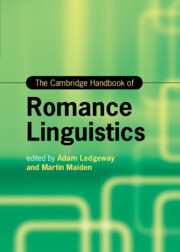Book contents
- The Cambridge Handbook of Romance Linguistics
- Cambridge Handbooks in Language and Linguistics
- The Cambridge Handbook of Romance Linguistics
- Copyright page
- Dedication
- Contents
- Figures
- Tables
- Contributors
- Abbreviations
- 1 Data, Theory, and Explanation: The View from Romance
- Part One What Is a Language?
- Part Two Phonetics and Phonology
- Part Three Morphology
- 10 Phonological and Morphological Conditioning
- 11 The Autonomy of Morphology
- 12 Suppletion
- 13 Inflexion, Derivation, Compounding
- 14 Evaluative Suffixes
- 15 Counting Systems
- Part Four Syntax
- Part Five Semantics and Pragmatics
- Part Six Language, Society, and the Individual
- Index
- References
10 - Phonological and Morphological Conditioning
from Part Three - Morphology
Published online by Cambridge University Press: 23 June 2022
- The Cambridge Handbook of Romance Linguistics
- Cambridge Handbooks in Language and Linguistics
- The Cambridge Handbook of Romance Linguistics
- Copyright page
- Dedication
- Contents
- Figures
- Tables
- Contributors
- Abbreviations
- 1 Data, Theory, and Explanation: The View from Romance
- Part One What Is a Language?
- Part Two Phonetics and Phonology
- Part Three Morphology
- 10 Phonological and Morphological Conditioning
- 11 The Autonomy of Morphology
- 12 Suppletion
- 13 Inflexion, Derivation, Compounding
- 14 Evaluative Suffixes
- 15 Counting Systems
- Part Four Syntax
- Part Five Semantics and Pragmatics
- Part Six Language, Society, and the Individual
- Index
- References
Summary
Phonology/phonetics and morphology interact in such a way as to render difficult any clear-cut dividing line between these subfields. Romanists have long observed that phonetics play a crucial role in language change. From this point of view there is nothing exceptional in the fact that phonetics/phonology may provide the system with the very substance of morphological oppositions. The number and the extension of the morphological processes amenable to phonetic principles in the Romance domain are so wide that only a few typical phenomena are treated in this chapter. Furthermore, it is not always evident how one can establish the extent to which a given morphological alternation is phonologically driven, whether we are dealing with a purely phonological phenomenon or whether we should recognize some lexical conditioning in the choice of the allomorphs. The examples discussed (allomorphy in the definite article, subject clitics and affixes, possessives, and the nominal, verbal, and adjectival stems) show that the phonetic impulse for a morphological alternation may no longer be transparent ; in other cases, the trigger of a given pattern is no longer available or can only be identified following a process of diachronic reconstruction.
- Type
- Chapter
- Information
- The Cambridge Handbook of Romance Linguistics , pp. 321 - 345Publisher: Cambridge University PressPrint publication year: 2022



